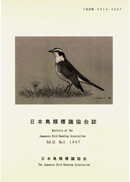All issues

Volume 12 (1997)
- Issue 2 Pages 31-
- Issue 1 Pages 1-
Volume 12, Issue 2
Displaying 1-3 of 3 articles from this issue
- |<
- <
- 1
- >
- >|
-
Michio FUKUDA1997 Volume 12 Issue 2 Pages 31-38
Published: 1997
Released on J-STAGE: August 20, 2015
JOURNAL FREE ACCESSA colony of Great Cormorants Phalacrocorax carbo was established on three small islands in Shinobazu Pond, Ueno Park, located in Taito Ward, Tokyo. Great cormorants had been nearly extirpated in the Kanto area, and this colony originated from birds that were raised and released at Ueno Park. In early October of 1987, a small sub-colony was formed in Morigasaki, Ota Ward, a distance of about 18 kilometers from the Shinobazu colony (Fig. 1). The relationship between these two colonies was investigated by tracking the movements of cormorants color-banded at Shinobazu Pond. Breeding habits at the two colonies were also investigated and compared. Research results showed that the majority of immigrants to the sub-colony consisted of younger (under three breeding seasons) individuals. In addition, breeding at the new colony was discovered to take place throughout the year, including the non-breeding season at Shinobazu Pond. These results suggest that cormorants that had lost breeding synchronization immigrated to the new colony; or that the young breeders were not influenced by the breeding cycle at their natal colony.View full abstractDownload PDF (1468K)
-
Yasuro SHIRASAKA1997 Volume 12 Issue 2 Pages 39-40
Published: 1997
Released on J-STAGE: August 20, 2015
JOURNAL FREE ACCESSA dwarfish Rustic Bunting Emberiza rustica was captured at Oume City, in the western part of Tokyo, on 13 November 1997. Main measurements of this juvenile female were as follows; wing length 67.8 mm (right wing), 68.0 mm (left wing), tail length 54 mm, exposed culmen 10.5 mm, tarsus length 18.8 mm, body weight 16.0 g. Although dwarfish Rustic Buntings had occasionally been captured in Japan, this was the first time that detail records were reported.View full abstractDownload PDF (335K)
-
Masaharu HAYAKAWA, Jeffery A. GORE1997 Volume 12 Issue 2 Pages 41-52
Published: 1997
Released on J-STAGE: August 20, 2015
JOURNAL FREE ACCESSLittle Terns Sterna albifrons in Japan originally nested on river spits and gravels and along sandy coasts. In recent years, however, these natural breeding habitats have been eliminated or deteriorated, and the remaining terns nest on yet-to-be-utilized landfill in ports and coastal industrial zones. Even these sites, however, will eventually be built on, and thus cannot be counted on as permanent. Given the high coast of coastal land in Japan, setting aside of sufficient ground breeding reserves will be difficult or impossible. In this environment, rooftop breeding sites, which can be provided even in congested areas, may be the most feasible hope for future preservation of this species.
As a first step in design and implementation of rooftop nesting sites in Chiba City, research was conducted on existing rooftop sites in northern Florida, along the Gulf of Mexico coast (Fig. 1). As a result of field observations and analysis of data, the following recommendations were prepared:
1. The rooftop should be covered with light-colored gravel.
2. To prevent chicks falling off, and to provided some protection from the sun, the roof should be edged with a wall at least 20 cm high.
3. A colony at Mihama Ward, Chiba Prefecture, would require at least 500 nests to be large enough for the terns to defend their eggs and chicks against predators. This number of would require a rooftop area of at least 17,000m2 (17ha).
4. Predator control, especially thinning of the local Jungle Crow Corvus macrorhynchos, should be considered.
5. The site must be within easy distance of shoals and tidal flats that serve as feeding grounds.View full abstractDownload PDF (2578K)
- |<
- <
- 1
- >
- >|